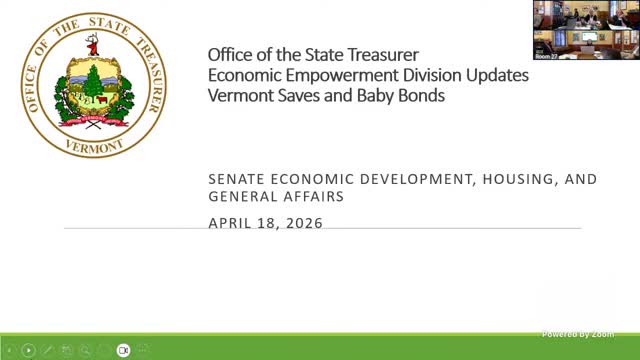Treasurer’s office updates committee on Vermont Saves auto‑IRA rollout; enrollment and outreach remain priorities
April 19, 2025 | Economic Development, Housing & General Affairs, SENATE, Committees, Legislative , Vermont
This article was created by AI summarizing key points discussed. AI makes mistakes, so for full details and context, please refer to the video of the full meeting. Please report any errors so we can fix them. Report an error »

State Treasurer’s Office staff briefed the Senate Economic Development, Housing & General Affairs Committee on April 18 about Vermont Saves, the state’s auto‑IRA program for workers whose employers do not offer workplace retirement plans, and about related policy work on baby bonds and rental payment reporting.
Becky Wasserman of the Treasurer’s Office (presenting the item) said Vermont Saves requires employers with five or more employees who do not offer a retirement plan to register and automatically enroll eligible employees in a Roth IRA with an opt‑out. Eligible workers must be 18 or older and have a Social Security number or ITIN. The program launched a pilot in October, opened to the public December 1 and had an official enrollment period through February; the treasurer’s staff are now following up with employers who have not engaged.
Early program metrics reported to the committee: roughly 1,622 funded employee accounts as of the update, about 1,300 additional accounts in the pending 30‑day decision window, and about 1,000 employers registered or otherwise responded (the office reported a roughly 53% response rate among employers initially contacted). Treasurer’s staff estimated approximately 75,000–85,000 Vermonters lack access to workplace retirement plans—an estimate used to justify the program’s public‑good rationale.
Default rules: automatic enrollment at a 5% deduction with an auto‑escalation provision of 1% per year up to 8% (staff proposed raising the statutory maximum auto‑escalation cap to 10% to align with federal changes and consortium practice); initial deposits are held in a capital‑preservation money‑market vehicle for 30 days before being placed into a target‑date suite if the employee takes no action. The treasurer explained employees may opt out by visiting the portal or by calling a support line; employers and staff noted some constituents were surprised by automatic enrollment and suggested more outreach and clearer onboarding communications. The treasurer’s office is part of a multistate consortium (Colorado, Delaware, Maine and others) that operates similar auto‑IRA programs.
Committee members asked how many employees opted out versus stayed in; staff said current figures categorize employers’ responses and that employee opt‑out rates were about 25–30% of those receiving enrollment notices in early data, while noting timing lags between employer registration, the 30‑day employee decision window and first payroll deductions. Members urged additional targeted outreach, clearer employer communications and potentially another enrollment push.
Wasserman also summarized requested statutory amendments: allow account holders to hold both Roth and traditional IRAs in the program so participants can receive forthcoming federal matches under Secure 2 (which places matching funds into traditional accounts), clarify employer eligibility language so businesses that no longer offer a plan may enroll, and increase the auto‑escalation cap. The treasurer’s office said it will continue outreach, refine marketing and provide updated enrollment metrics to the committee. Committee members asked the treasurer’s office to return with more detailed opt‑in/opt‑out statistics and additional outreach plans.
Becky Wasserman of the Treasurer’s Office (presenting the item) said Vermont Saves requires employers with five or more employees who do not offer a retirement plan to register and automatically enroll eligible employees in a Roth IRA with an opt‑out. Eligible workers must be 18 or older and have a Social Security number or ITIN. The program launched a pilot in October, opened to the public December 1 and had an official enrollment period through February; the treasurer’s staff are now following up with employers who have not engaged.
Early program metrics reported to the committee: roughly 1,622 funded employee accounts as of the update, about 1,300 additional accounts in the pending 30‑day decision window, and about 1,000 employers registered or otherwise responded (the office reported a roughly 53% response rate among employers initially contacted). Treasurer’s staff estimated approximately 75,000–85,000 Vermonters lack access to workplace retirement plans—an estimate used to justify the program’s public‑good rationale.
Default rules: automatic enrollment at a 5% deduction with an auto‑escalation provision of 1% per year up to 8% (staff proposed raising the statutory maximum auto‑escalation cap to 10% to align with federal changes and consortium practice); initial deposits are held in a capital‑preservation money‑market vehicle for 30 days before being placed into a target‑date suite if the employee takes no action. The treasurer explained employees may opt out by visiting the portal or by calling a support line; employers and staff noted some constituents were surprised by automatic enrollment and suggested more outreach and clearer onboarding communications. The treasurer’s office is part of a multistate consortium (Colorado, Delaware, Maine and others) that operates similar auto‑IRA programs.
Committee members asked how many employees opted out versus stayed in; staff said current figures categorize employers’ responses and that employee opt‑out rates were about 25–30% of those receiving enrollment notices in early data, while noting timing lags between employer registration, the 30‑day employee decision window and first payroll deductions. Members urged additional targeted outreach, clearer employer communications and potentially another enrollment push.
Wasserman also summarized requested statutory amendments: allow account holders to hold both Roth and traditional IRAs in the program so participants can receive forthcoming federal matches under Secure 2 (which places matching funds into traditional accounts), clarify employer eligibility language so businesses that no longer offer a plan may enroll, and increase the auto‑escalation cap. The treasurer’s office said it will continue outreach, refine marketing and provide updated enrollment metrics to the committee. Committee members asked the treasurer’s office to return with more detailed opt‑in/opt‑out statistics and additional outreach plans.
View full meeting
This article is based on a recent meeting—watch the full video and explore the complete transcript for deeper insights into the discussion.
View full meeting